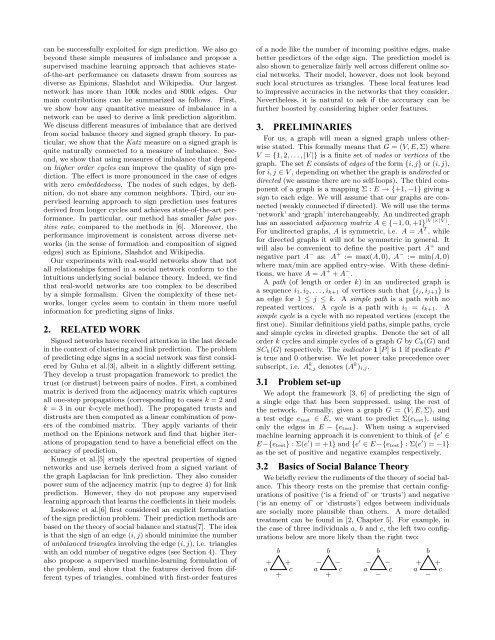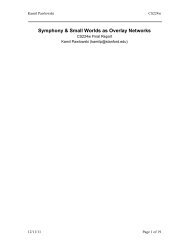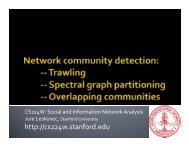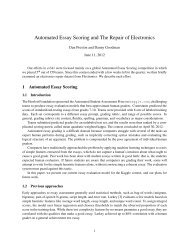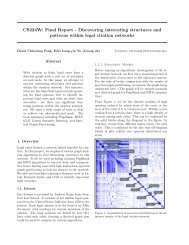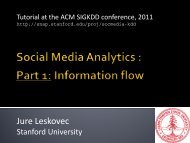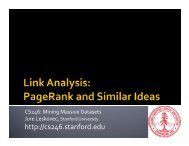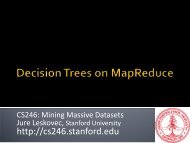Exploiting Longer Cycles for Link Prediction in Signed Networks
Exploiting Longer Cycles for Link Prediction in Signed Networks
Exploiting Longer Cycles for Link Prediction in Signed Networks
Create successful ePaper yourself
Turn your PDF publications into a flip-book with our unique Google optimized e-Paper software.
can be successfully exploited <strong>for</strong> sign prediction. We also go<br />
beyond these simple measures of imbalance and propose a<br />
supervised mach<strong>in</strong>e learn<strong>in</strong>g approach that achieves stateof-the-art<br />
per<strong>for</strong>mance on datasets drawn from sources as<br />
diverse as Ep<strong>in</strong>ions, Slashdot and Wikipedia. Our largest<br />
network has more than 100k nodes and 800k edges. Our<br />
ma<strong>in</strong> contributions can be summarized as follows. First,<br />
we show how any quantitative measure of imbalance <strong>in</strong> a<br />
network can be used to derive a l<strong>in</strong>k prediction algorithm.<br />
We discuss different measures of imbalance that are derived<br />
from social balance theory and signed graph theory. In particular,<br />
we show that the Katz measure on a signed graph is<br />
quite naturally connected to a measure of imbalance. Second,<br />
we show that us<strong>in</strong>g measures of imbalance that depend<br />
on higher order cycles can improve the quality of sign prediction.<br />
The effect is more pronounced <strong>in</strong> the case of edges<br />
with zero embeddedness. The nodes of such edges, by def<strong>in</strong>ition,<br />
do not share any common neighbors. Third, our supervised<br />
learn<strong>in</strong>g approach to sign prediction uses features<br />
derived from longer cycles and achieves state-of-the-art per<strong>for</strong>mance.<br />
In particular, our method has smaller false positive<br />
rate, compared to the methods <strong>in</strong> [6]. Moreover, the<br />
per<strong>for</strong>mance improvement is consistent across diverse networks<br />
(<strong>in</strong> the sense of <strong>for</strong>mation and composition of signed<br />
edges) such as Ep<strong>in</strong>ions, Slashdot and Wikipedia.<br />
Our experiments with real-world networks show that not<br />
all relationships <strong>for</strong>med <strong>in</strong> a social network con<strong>for</strong>m to the<br />
<strong>in</strong>tuitions underly<strong>in</strong>g social balance theory. Indeed, we f<strong>in</strong>d<br />
that real-world networks are too complex to be described<br />
by a simple <strong>for</strong>malism. Given the complexity of these networks,<br />
longer cycles seem to conta<strong>in</strong> <strong>in</strong> them more useful<br />
<strong>in</strong><strong>for</strong>mation <strong>for</strong> predict<strong>in</strong>g signs of l<strong>in</strong>ks.<br />
2. RELATED WORK<br />
<strong>Signed</strong> networks have received attention <strong>in</strong> the last decade<br />
<strong>in</strong> the context of cluster<strong>in</strong>g and l<strong>in</strong>k prediction. The problem<br />
of predict<strong>in</strong>g edge signs <strong>in</strong> a social network was first considered<br />
by Guha et al.[3], albeit <strong>in</strong> a slightly different sett<strong>in</strong>g.<br />
They develop a trust propagation framework to predict the<br />
trust (or distrust) between pairs of nodes. First, a comb<strong>in</strong>ed<br />
matrix is derived from the adjacency matrix which captures<br />
all one-step propagations (correspond<strong>in</strong>g to cases k = 2 and<br />
k = 3 <strong>in</strong> our k-cycle method). The propagated trusts and<br />
distrusts are then computed as a l<strong>in</strong>ear comb<strong>in</strong>ation of powers<br />
of the comb<strong>in</strong>ed matrix. They apply variants of their<br />
method on the Ep<strong>in</strong>ions network and f<strong>in</strong>d that higher iterations<br />
of propagation tend to have a beneficial effect on the<br />
accuracy of prediction.<br />
Kunegis et al.[5] study the spectral properties of signed<br />
networks and use kernels derived from a signed variant of<br />
the graph Laplacian <strong>for</strong> l<strong>in</strong>k prediction. They also consider<br />
power sum of the adjacency matrix (up to degree 4) <strong>for</strong> l<strong>in</strong>k<br />
prediction. However, they do not propose any supervised<br />
learn<strong>in</strong>g approach that learns the coefficients <strong>in</strong> their models.<br />
Leskovec et al.[6] first considered an explicit <strong>for</strong>mulation<br />
of the sign prediction problem. Their prediction methods are<br />
based on the theory of social balance and status[7]. The idea<br />
is that the sign of an edge (i, j) should m<strong>in</strong>imize the number<br />
of unbalanced triangles <strong>in</strong>volv<strong>in</strong>g the edge (i, j), i.e. triangles<br />
with an odd number of negative edges (see Section 4). They<br />
also propose a supervised mach<strong>in</strong>e-learn<strong>in</strong>g <strong>for</strong>mulation of<br />
the problem, and show that the features derived from different<br />
types of triangles, comb<strong>in</strong>ed with first-order features<br />
of a node like the number of <strong>in</strong>com<strong>in</strong>g positive edges, make<br />
better predictors of the edge sign. The prediction model is<br />
also shown to generalize fairly well across different onl<strong>in</strong>e social<br />
networks. Their model, however, does not look beyond<br />
such local structures as triangles. These local features lead<br />
to impressive accuracies <strong>in</strong> the networks that they consider.<br />
Nevertheless, it is natural to ask if the acccuracy can be<br />
further boosted by consider<strong>in</strong>g higher order features.<br />
3. PRELIMINARIES<br />
For us, a graph will mean a signed graph unless otherwise<br />
stated. This <strong>for</strong>mally means that G = (V, E, Σ) where<br />
V = {1, 2, . . . , |V |} is a f<strong>in</strong>ite set of nodes or vertices of the<br />
graph. The set E consists of edges of the <strong>for</strong>m {i, j} or (i, j),<br />
<strong>for</strong> i, j ∈ V , depend<strong>in</strong>g on whether the graph is undirected or<br />
directed (we assume there are no self-loops). The third component<br />
of a graph is a mapp<strong>in</strong>g Σ : E → {+1, −1} giv<strong>in</strong>g a<br />
sign to each edge. We will assume that our graphs are connected<br />
(weakly connected if directed). We will use the terms<br />
‘network’ and ‘graph’ <strong>in</strong>terchangeably. An undirected graph<br />
has an associated adjacency matrix A ∈ {−1, 0, +1} |V |×|V | .<br />
For undirected graphs, A is symmetric, i.e. A = A T , while<br />
<strong>for</strong> directed graphs it will not be symmetric <strong>in</strong> general. It<br />
will also be convenient to def<strong>in</strong>e the positive part A + and<br />
negative part A − as: A + := max(A,0), A − := m<strong>in</strong>(A,0)<br />
where max/m<strong>in</strong> are applied entry-wise. With these def<strong>in</strong>itions,<br />
we have A = A + + A − .<br />
A path (of length or order k) <strong>in</strong> an undirected graph is<br />
a sequence i1, i2, . . . , ik+1 of vertices such that {ij, ij+1} is<br />
an edge <strong>for</strong> 1 ≤ j ≤ k. A simple path is a path with no<br />
repeated vertices. A cycle is a path with i1 = ik+1. A<br />
simple cycle is a cycle with no repeated vertices (except the<br />
first one). Similar def<strong>in</strong>itions yield paths, simple paths, cycle<br />
and simple cycles <strong>in</strong> directed graphs. Denote the set of all<br />
order k cycles and simple cycles of a graph G by Ck(G) and<br />
SCk(G) respectively. The <strong>in</strong>dicator 1[P] is 1 if predicate P<br />
is true and 0 otherwise. We let power take precedence over<br />
subscript, i.e. A k i,j denotes (A k )i,j.<br />
3.1 Problem set-up<br />
We adopt the framework [3, 6] of predict<strong>in</strong>g the sign of<br />
a s<strong>in</strong>gle edge that has been suppressed, us<strong>in</strong>g the rest of<br />
the network. Formally, given a graph G = (V, E, Σ), and<br />
a test edge etest ∈ E, we want to predict Σ(etest), us<strong>in</strong>g<br />
only the edges <strong>in</strong> E − {etest}. When us<strong>in</strong>g a supervised<br />
mach<strong>in</strong>e learn<strong>in</strong>g approach it is convenient to th<strong>in</strong>k of {e ′ ∈<br />
E−{etest} : Σ(e ′ ) = +1} and {e ′ ∈ E−{etest} : Σ(e ′ ) = −1}<br />
as the set of positive and negative examples respectively.<br />
3.2 Basics of Social Balance Theory<br />
We briefly review the rudiments of the theory of social balance.<br />
This theory rests on the premise that certa<strong>in</strong> configurations<br />
of positive (‘is a friend of’ or ‘trusts’) and negative<br />
(‘is an enemy of’ or ‘distrusts’) edges between <strong>in</strong>dividuals<br />
are socially more plausible than others. A more detailed<br />
treatment can be found <strong>in</strong> [2, Chapter 5]. For example, <strong>in</strong><br />
the case of three <strong>in</strong>dividuals a, b and c, the left two configurations<br />
below are more likely than the right two:<br />
a +<br />
b<br />
+<br />
+ c<br />
a −<br />
b<br />
+<br />
− c<br />
a −<br />
b<br />
−<br />
− c<br />
a +<br />
b<br />
−<br />
+ c


